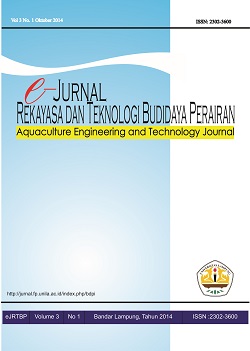Efektifitas Sistem Akuaponik dalam Mereduksi Konsentrasi Amonia pada Sistem Budidaya Ikan
Abstract
Kualitas air memegang peranan penting dalam bidang perikanan terutama untuk kegiatan budidaya serta produktifitas hewan akuatik. Limbah yang dihasilkan dari proses budidaya memiliki dampak negatif bagi hewan akuatik. Amonia merupakan salah satu limbah yang berasal dari sisa metabolisme ikan yang terlarut dalam air berupa feses dan sisa makanan ikan yang tidak termakan dan mengendap di dasar kolam budidaya. Penelitian ini bertujuan untuk mengetahui efektifitas sistem akuaponik dalam mereduksi kadar amonia serta mengetahui jumlah kepadatan optimal tanaman pada sistem akuaponik dalam menyerap kadar amonia. Penelitian dilaksanakan selama 60 hari pada Juli-September 2013 bertempat di Laboratorium Budidaya Perikanan Universitas Lampung. Perlakuan penelitian menggunakan kangkung (Ipomoea aquatica) 10 batang, 20 batang, 30 batang per rumpun dan tidak menggunakan tanaman. Pengurangan amonia oleh tanaman air digunakan untuk pertumbuhan yang diserap melalui jaringan akar. Semakin banyak tanaman air makin efektif dalam mereduksi amonia. Penggunaan 30 batang per rumpun kangkung dapat mengurangi amonia hingga 58,57mg/l.
Downloads
Downloads
Published
How to Cite
Issue
Section
License
License for Authors
Authors who publish with this journal agree to the following terms:
- Authors retain copyright and grant the journal right of first publication with the work simultaneously licensed under a Creative Commons Attribution-ShareAlike 4.0 International License that allows others to share the work with an acknowledgement of the work's authorship and initial publication in this journal.
- Authors are able to enter into separate, additional contractual arrangements for the non-exclusive distribution of the journal's published version of the work (e.g., post it to an institutional repository or publish it in a book), with an acknowledgement of its initial publication in this journal.
- Authors are permitted and encouraged to post their work online (e.g., in institutional repositories or on their website) prior to and during the submission process, as it can lead to productive exchanges, as well as earlier and greater citation of published work (See The Effect of Open Access).
- The Author warrant that this article is original and that the author has full power to publish. The author sign for and accepts responsibility for releasing this material on behalf of any and all-author. If the article based on or part of student’s thesis, the student needs to sign as his/her agreement that his/her works is going published.
License for Regular Users
Other regular users who want to cite, distribute, remix, tweak, and build upon author’s works, even for commercial purposes, should acknowledge the work’s authorship and initial publication in this journal, licensed under a Creative Commons Attribution-ShareAlike 4.0 International License.
This license lets others distribute, remix, tweak, and build upon your work, even commercially, as long as they credit you for the original creation.

This work is licensed under a Creative Commons Attribution-ShareAlike 4.0 International License.





















